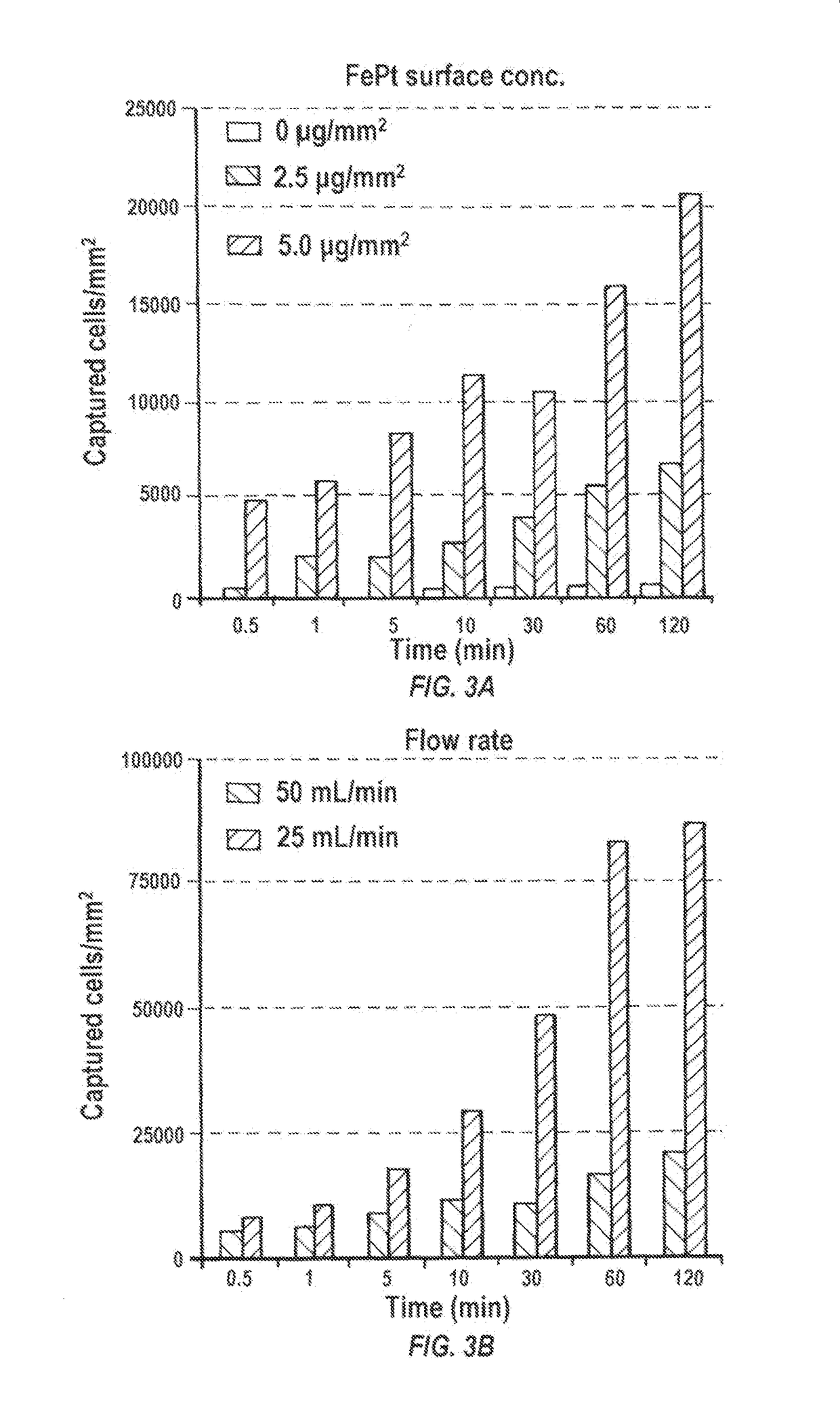Iron platinum particles for adherence of biologics on medical implants
a technology of iron platinum particles and biologics, applied in the field of localized cell attraction, capture and retention in vivo, to avoid magnetization in situ
- Summary
- Abstract
- Description
- Claims
- Application Information
AI Technical Summary
Benefits of technology
Problems solved by technology
Method used
Image
Examples
example 1
ion of Magnetized Stents for Treating Restenosis
Materials and Methods
[0150]Synthesis of Iron / Platinum Particles
[0151]The synthesis involves simultaneous chemical reduction of Pt(acac)2 and Fe(acac)3 by 1,2-hexadecanediol at high temperature (250° C.) in solution phase. The synthesis was handled under standard airless techniques in an argon atmosphere. The reagents were obtained from commercial sources and used without further purification. A mixture of 0.5 mmol of Pt(acac)2, 1.0 mmol of Fe(acac)3, and 1,2-hexadecanediol (5.0 mmol) was added to a 125 mL European flask containing a PTFE coated magnetic stir bar. Dioctyl ether (30 mL) was then transferred into the flask and the contents stirred while purging with Ar for 20 min at room temperature. The flask was then heated to 100° C. and held at 100° C. for 20 min. During this hold, 0.05 mmol (0.17 mL) of oleylamine and 0.05 mmol (0.16 mL) of oleic acid were injected into the flask while continuing the Ar purge. After the 20 min hold, ...
example 2
d Cells are Retained on Magnetized Stents In Vitro
[0185]Materials and Methods
[0186]Dye release
[0187]Coating stability of polymer layer in the presence of Fe / Pt particles, iodinated dendrimer (ID) particles or both was studied by measuring dye release. Rhodamine B (1 wt. %) was dissolved in the PLA chloroform solution and the particles were added to the solution. The solutions with or without particles were dropped on the cover glasses and dried overnight. The cover glasses were incubated in PBS at 37° C. and PBS (1 mL) was taken to measure released dye at the desired time points.
[0188]Body Clearance
[0189]PLGA particles encapsulating DiR dye ((1,1′-Dioctadecyl-3,3,3′,3′-Tetramethylindotricarbocyanine Iodide), Life Technologies) and / or Fe / Pt were prepared with a typical emulsion method. Briefly, PLGA (75 mg), Fe / Pt (25 mg), and dir dye (1 mg) were dissolved in chloroform, and then added drop-wise to 5% polyvinyl alcohol (PVA). The mixture was sonicated three times and then added to 0....
example 3
tion of Magnetized Cells in PLGA Particles
[0198]Cells (such as endothelial cells, macrophages or progenitor cells) can be made magnetically susceptible by intracellular incorporation of iron oxide or attachment to the surface.
[0199]Materials and Methods
[0200]To facilitate enhanced loading of iron-oxide in cells. PLGA particles are fabricated by the double emulsion method encapsulating a high concentration of iron oxide and a dye (Coumarin 6). PLGA particles encapsulating hydrophobic superparamagnetic iron oxide (SPIO) were prepared and surface-functionalized with avidin-palmitic acid. Briefly, PLGA (107 mg) and hydrophobic SPIO (26 mg) were dissolved in chloroform (2 mL) and then added drop-wise to a vortexing solution of 5% PVA (4 mL) and the resulting mixture was sonicated three times for 10 s at an amplitude of 38% (400 W). The mixture was then added drop-wise to 100 mL of 0.2% PVA and left stirring for 3h to evaporate the solvent. Particles were collected by centrifugation at 12...
PUM
| Property | Measurement | Unit |
|---|---|---|
| Temperature | aaaaa | aaaaa |
| Fraction | aaaaa | aaaaa |
| Fraction | aaaaa | aaaaa |
Abstract
Description
Claims
Application Information
 Login to View More
Login to View More - R&D
- Intellectual Property
- Life Sciences
- Materials
- Tech Scout
- Unparalleled Data Quality
- Higher Quality Content
- 60% Fewer Hallucinations
Browse by: Latest US Patents, China's latest patents, Technical Efficacy Thesaurus, Application Domain, Technology Topic, Popular Technical Reports.
© 2025 PatSnap. All rights reserved.Legal|Privacy policy|Modern Slavery Act Transparency Statement|Sitemap|About US| Contact US: help@patsnap.com



